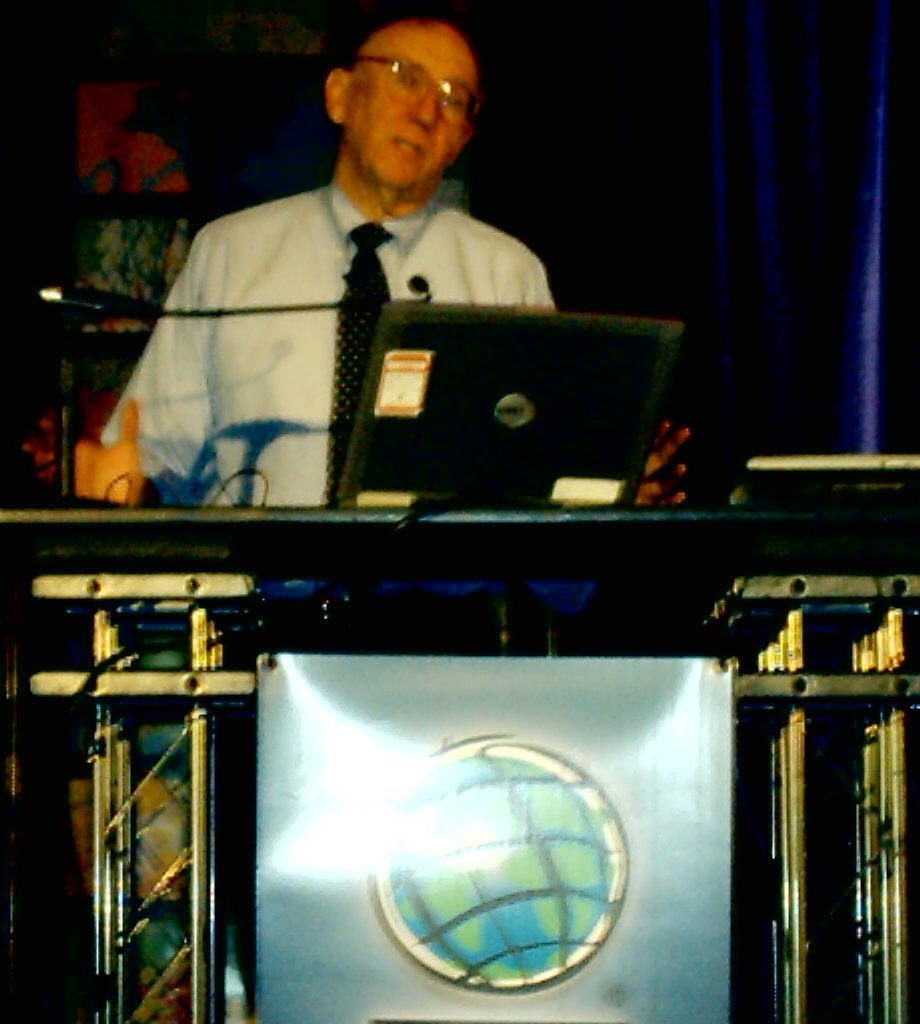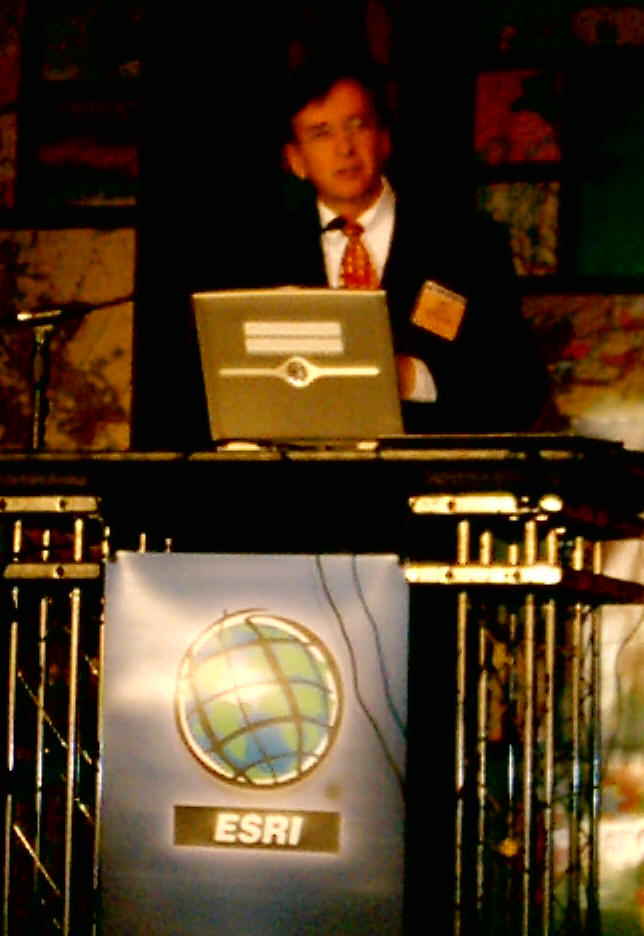 I spent Sunday night and Monday morning at the ESRI Homeland Security GIS Summit, which took place in Denver this week.As you read this report on Wednesday, the conference is winding down.
I spent Sunday night and Monday morning at the ESRI Homeland Security GIS Summit, which took place in Denver this week.As you read this report on Wednesday, the conference is winding down.
The line up of speakers and recent events (Hurricane Katrina in particular) gave the meeting a believable sense of "there is no more valuable use of your time than to be here right now, learning what is the state-of-the-art in emergency response, and working together on how we collectively can improve on it." After 20 years in the industry, I don't make this statement lightly.
Sunday evening and Monday morning was "conference tone setting" time. There were about 260 people pre-registered, so this was a small, relatively intimate meeting.During Sunday's reception attendees could check out the posters and catch up with old friends.I appreciated having the opportunity to look at the posters on Sunday, as they helped clarify for me what the conference boundaries were.Initially, I wasn't sure what would fall under the "homeland security" umbrella, but after looking at the posters, I offer this definition: "analyzing, planning for and responding to catastrophic events, be they man-made in origin, or natural." Poster topics ran the gamut from hurricanes, fires and hazardous materials to agro-terrorism and bio-chemical attacks.
Russ Johnson, ESRI's homeland security and public safety industry manager, provided an overview of the conference theme: "GIS for intelligent collaboration" across boundaries, at all levels and integrated, to help "create a common picture" for everyone involved in planning for or mitigating the effects of a catastrophic event.This boils down to a data issue - putting the right data, processed in the right way, and delivered in the right format, into the hands of the right people (all of the right people), at the right time.
Denver Mayor John Hickenlooper primarily focused on the coordination of delivering data."We hope not to have a major terrorist strike or natural disaster on the level of what we've seen on the Gulf Coast, but we all benefit from having the infrastructure to be prepared," he explained.Barbara Kirkmeyer, Director of the Colorado Department of Local Affairs, described how the Colorado Emergency Operation Center was currently busy working on finding housing for displaced Hurricane Katrina survivors.
Senator Joe Biden (D-Delaware) appeared via videotape because the John Roberts confirmation hearings prevented him from attending in person. His key message (other than a little bit of a love letter to ESRI) was that the federal government "has to be able to do better" in responding to catastrophic events.
 |
Jack Dangermond pointed out that many people who should have been there weren't able to attend because of Hurricane Katrina response activities, but asked people to do their utmost to learn and share.He provided his vision of a world that is evolving rapidly and needs improved tools to be understood."Our field, geospatial information, is becoming very valuable as a language," he said, focusing on the integration that is inherent in the theoretical structure of GIS.In the arena of emergency management, this integrating aspect is "attractive because it helps us make better decisions." However, he felt that "while we have a lot of GIS down in New Orleans, it's not very well brought together." After the terrorist attack in New York, it took about eight days to pull together the necessary information to have an operational GIS that could be used to respond to the situation, he said."It's my sense that this [compilation of available resources] is what's happening in Louisiana now."
Dangermond's vision: "We're not very good at bringing all this together now - we're maybe pretty good at it if you look at it one city at a time.But I have a vision that we could be good at it across the nation" at some point in the future.He went on to quickly describe a handful of applications where this would apply (e.g.human health and disease surveillance, real-time tracking of hazmat, evacuation planning, etc.) He mentioned the Geospatial One Stop portal (with more than 70,000 registered services available) as one possible model for making this happen.
ESRI's John Calkins then demoed a series of wonderfully spooky applications.My favorite analyzed an Iranian uranium fuel enrichment facility in Natanz, using imagery and maps to locate it, watch it be built over time, watch portions of it be buried under the sand, etc.He then showed how he built a model of location criteria to search for a back-up uranium fuel enrichment facility (bingo! - showed up right where he thought it would).I won't try to describe this application - you had to be there.However, the demo definitely left you feeling like you shouldn't be involved in any activities you don't want Big Brother to know about, because he can definitely find out if he wants to...
 |
Jeremy Harris, former mayor of the City and County of Honolulu (see interview from one year ago,) is a strong proponent of enterprisewide GIS.He credits the system with turning around the economic stability of the recently waning Waikiki part of town.
Harris reminded the audience that more people than ever live in cities, and cities are extremely vulnerable to any "disruption of infrastructure." He feels that the risk to cities is enormous, and growing, for two reasons.First, infrastructure is deteriorating, and federal monies that used to support city infrastructure development and maintenance are no longer available.Second, he points to global warming - which he feels is a greater risk than terrorism.Neither of those is going to improve until there are major changes in our political landscape, he said, that will allow a focus on both rebuilding infrastructure and developing a coherent energy policy that lessens dependence on fossil fuels.As a side note, he knocked FEMA pretty hard, describing it as an "ineffective shell" of its former self .One has to give Harris credit for not holding back.
Harris discussed two problems that lead to disorganized government IT situations.First, he believes there's a systemic problem in how governments are structured.There are too many overlapping jurisdictions.This leads to the second problem - the decentralized authority inherent in overlapping jurisdictions lacks the punch necessary to make meaningful changes to information technology policy, and force collaboration.A statement he made, which I noticed caused a few people to squirm in their seats, was that county government should be abolished.This could make sense in urbanized areas, but probably not for rural areas.I live in rural northwest Colorado, where county government is the only government for big chunks of unincorporated land with there is little overlap.
Harris forced change in his role in Honolulu as an admittedly "strong mayor" by a) devolving IT-related authority from individual departments and giving it to a CIO; b) building teams that force/foster interpersonal relationships that break down barriers to sharing resources (especially data resources); and c) standardizing data and software so that technology can be deployed in an enterprisewide manner."My message is the importance of the enterprisewide GIS to enhance collaboration - it is the critical piece of technology," he said.
Harris detailed many applications enabled by an enterprisewide strategy to GIS.Highlights were public access, emergency scenarios (the most likely being a tsunami) and economic development.He finished by saying that he feels the most important technology challenge we're facing right now is, in fact, not a technology problem but a political problem."If every citizen could see what we saw [at the conference] this morning, I think we would see a sea state change in the level of funding" for enterprisewise GIS.
Given what we know of government's poor preparation and response to Hurricane Katrina, this was a timely gathering.